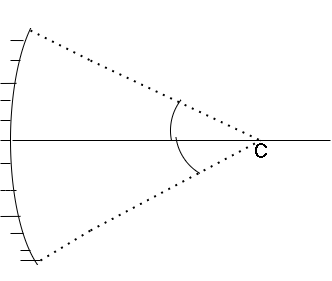
The circular boundary of the concave mirror subtends a cone of half angle \[\theta \] at its center of curvature. The minimum value of \[\theta \] for which ray incident on this mirror parallel to the principal axis suffers reflection more than one is:
A) \[{30^\circ}\]
B) \[{45^\circ}\]
C) \[{60^\circ}\]
D) \[{75^\circ}\]
Answer
169.8k+ views
Hint: Multiple reflection of light is the reflection of light that happens between reflecting surfaces many a times. If a light that is reflected from a surface is made to incident on another surface, this process is called multiple reflection of light.
Complete step by step solution:
When two mirrors are placed in front of each other, then multiple images are formed. This is because the image formed by one mirror will act as an object to the second mirror. This pattern continues and further images of image are formed. If the mirrors are placed at some angle to each other then the reflections produced will be curved. The number of reflections can be increased by increasing the number of mirrors. These days multiple reflection of sound waves principle is used to make a stethoscope used by doctors to check heartbeat or pulse rate.
An incident ray will suffer many reflections if it is incident on only one part of the mirror. It reflects in a perpendicular direction and intersects the other side of the mirror. This is obtained if the angle of incidence is \[{45^ \circ }\]. Let the angle between them be \[\theta \]. Since the reflected ray will act as incident ray to other surfaces so \[\angle i = \angle r\].

\[\Rightarrow \angle i + \angle r = {90^ \circ }\]
\[\Rightarrow \theta + \theta = {90^ \circ }\]
\[\Rightarrow 2\theta = {90^ \circ }\]
\[\Rightarrow \theta = {45^ \circ }\]
The minimum value for which the incident ray will suffer many reflections is \[{45^ \circ }\].
Option B is the correct answer.
Note: If the plane mirrors are used for multiple reflections and if the angle between the plane mirrors is \[\theta \], then the number of images formed can be calculated by using \[n = 360\theta - 1\].
Complete step by step solution:
When two mirrors are placed in front of each other, then multiple images are formed. This is because the image formed by one mirror will act as an object to the second mirror. This pattern continues and further images of image are formed. If the mirrors are placed at some angle to each other then the reflections produced will be curved. The number of reflections can be increased by increasing the number of mirrors. These days multiple reflection of sound waves principle is used to make a stethoscope used by doctors to check heartbeat or pulse rate.
An incident ray will suffer many reflections if it is incident on only one part of the mirror. It reflects in a perpendicular direction and intersects the other side of the mirror. This is obtained if the angle of incidence is \[{45^ \circ }\]. Let the angle between them be \[\theta \]. Since the reflected ray will act as incident ray to other surfaces so \[\angle i = \angle r\].

\[\Rightarrow \angle i + \angle r = {90^ \circ }\]
\[\Rightarrow \theta + \theta = {90^ \circ }\]
\[\Rightarrow 2\theta = {90^ \circ }\]
\[\Rightarrow \theta = {45^ \circ }\]
The minimum value for which the incident ray will suffer many reflections is \[{45^ \circ }\].
Option B is the correct answer.
Note: If the plane mirrors are used for multiple reflections and if the angle between the plane mirrors is \[\theta \], then the number of images formed can be calculated by using \[n = 360\theta - 1\].
Recently Updated Pages
Molarity vs Molality: Definitions, Formulas & Key Differences

Preparation of Hydrogen Gas: Methods & Uses Explained

Polymers in Chemistry: Definition, Types, Examples & Uses

P Block Elements: Definition, Groups, Trends & Properties for JEE/NEET

Order of Reaction in Chemistry: Definition, Formula & Examples

Hydrocarbons: Types, Formula, Structure & Examples Explained

Trending doubts
JEE Main 2025 Session 2: Application Form (Out), Exam Dates (Released), Eligibility, & More

Displacement-Time Graph and Velocity-Time Graph for JEE

Electric field due to uniformly charged sphere class 12 physics JEE_Main

Uniform Acceleration

JEE Main 2025: Derivation of Equation of Trajectory in Physics

Instantaneous Velocity - Formula based Examples for JEE

Other Pages
JEE Advanced Marks vs Ranks 2025: Understanding Category-wise Qualifying Marks and Previous Year Cut-offs

Learn About Angle Of Deviation In Prism: JEE Main Physics 2025

JEE Advanced Weightage 2025 Chapter-Wise for Physics, Maths and Chemistry

Wheatstone Bridge for JEE Main Physics 2025

JEE Main 2025: Conversion of Galvanometer Into Ammeter And Voltmeter in Physics

Electric Field Due to Uniformly Charged Ring for JEE Main 2025 - Formula and Derivation




